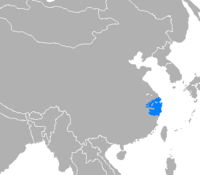
Photo from wikipedia
This study aimed to determine the environmental and ecological factors influencing the planktonic prokaryotic community profiles in the composite ecosystem comprising Taihu Lake, Taipu River, and Jinze Reservoir in the… Click to show full abstract
This study aimed to determine the environmental and ecological factors influencing the planktonic prokaryotic community profiles in the composite ecosystem comprising Taihu Lake, Taipu River, and Jinze Reservoir in the Taihu Watershed in China. A total of 42 water samples were intermittently collected from different sites in six months across four seasons. Physicochemical characteristics of the ecosystem, bacterioplankton diversity, and composition, the presence of co-occurrence patterns, and environmental predictors of ecological modules in the bacterioplankton network were determined. The central species played a more important role in regulating the structure and function of the bacterioplankton community and in responding to environmental contamination than the entire community. The relative abundance of the phylum Proteobacteria and the class Betaproteobacteria varied significantly between months and locations, which were identified as core functional taxa. A nonrandom co-occurrence pattern and function-driven modular structure were observed in the bacterioplankton co-occurrence network. Dissolved oxygen and ammonium nitrogen were the major and mutual environmental predictors of the bacterioplankton community composition, functional attributes, and relative abundance of ecological modules. The results improve our understanding of the impact of anthropogenic contamination on bacterioplankton diversity and biogeochemical cycles and the formulation of strategies for bioremediation of the Taihu Watershed.
Journal Title: FEMS microbiology ecology
Year Published: 2020
Link to full text (if available)
Share on Social Media: Sign Up to like & get
recommendations!